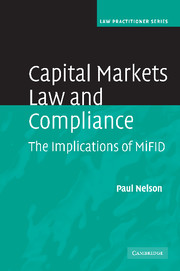Book contents
- Frontmatter
- Contents
- Preface
- List of acronyms
- Part I Evolution of capital markets regulation, FSA and the European single market
- Part II Licensing and rule application
- 3 Licensing
- 4 The application of FSA MiFID rules
- Part III The firm's infrastructure
- Part IV Conduct of business
- Part V Application of rules to particular businesses
- Bibliography
- Index
4 - The application of FSA MiFID rules
Published online by Cambridge University Press: 03 December 2009
- Frontmatter
- Contents
- Preface
- List of acronyms
- Part I Evolution of capital markets regulation, FSA and the European single market
- Part II Licensing and rule application
- 3 Licensing
- 4 The application of FSA MiFID rules
- Part III The firm's infrastructure
- Part IV Conduct of business
- Part V Application of rules to particular businesses
- Bibliography
- Index
Summary
Methodology
Like any rule set, and this includes the application of the licensing requirement under FSMA itself (3.2), particular FSA rules or sets of FSA rules apply in accordance with the answers to three questions. First, to which activities, and in relation to which instruments, after applying the exclusions, does the rule/rule set apply? Second, to which institutions? And, third, in which (territorial) locations? As always with rules, which direct behavioural consequences as a result of conditions of application, this can be represented in four different ways: through words, in a descriptive manner albeit somewhat re-ordered from the regulator's original given the ways in which the rules are often expressed; through the use of flowcharts with yes/no directions to reach a conclusion; through a matrix; or through an even more radically schematic representation using formulae, all rules being ultimately reducible to the pattern X = Z – Y, i.e. X (rule consequence/application) if Z (conditions of application) unless Y (exemptions). The challenges in all forms of representation are the drafting style used in the original rule, the ordering of the rules and the defined terms so beloved of regulators.
Rules of application
Each of the numbered headings in Figure 5 is explained in the correspondingly numbered paragraphs that follow the Figure. Figure 5 is explained as follows in terms of the headings in the horizontal axis.
- Type
- Chapter
- Information
- Capital Markets Law and ComplianceThe Implications of MiFID, pp. 98 - 110Publisher: Cambridge University PressPrint publication year: 2008



